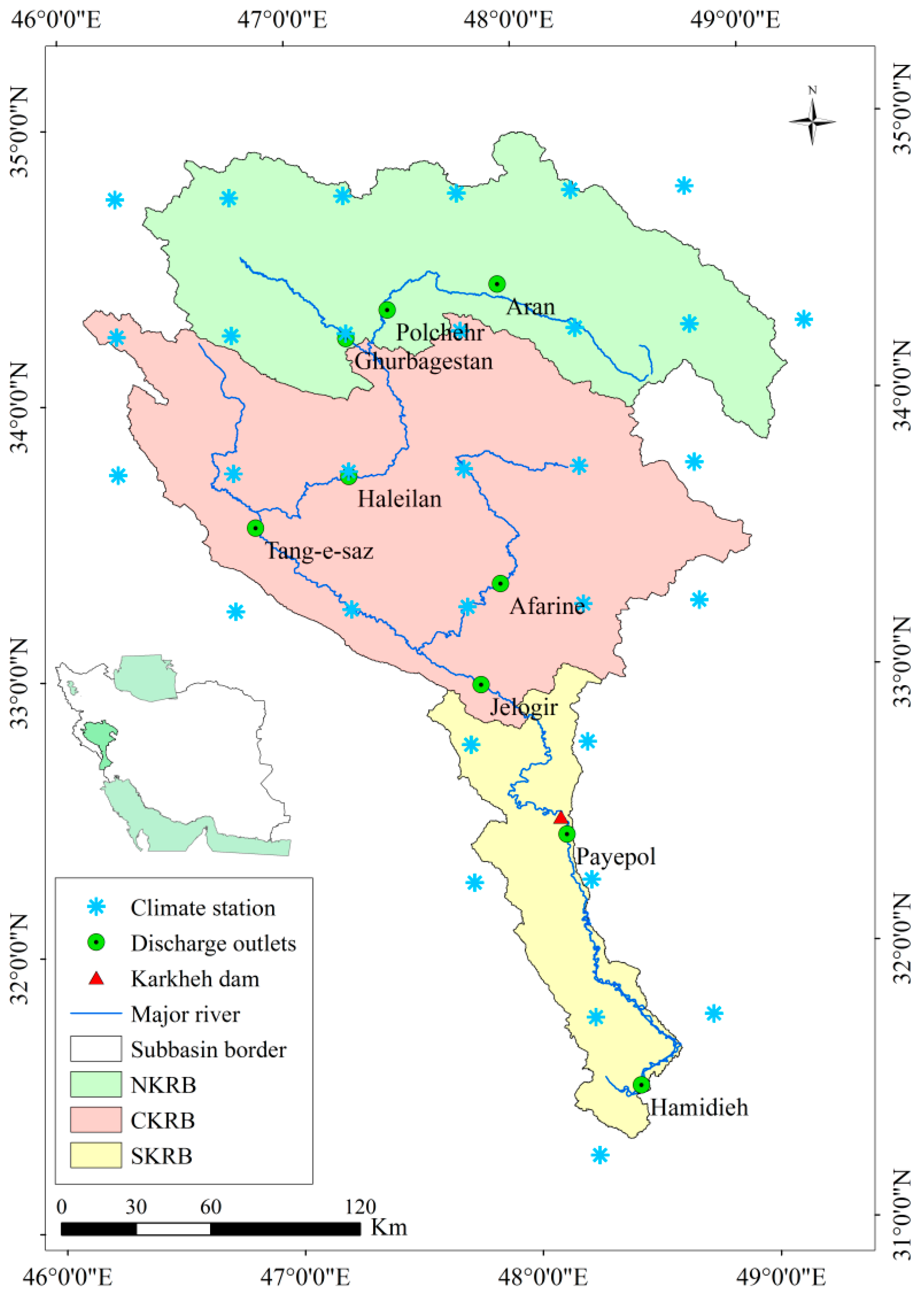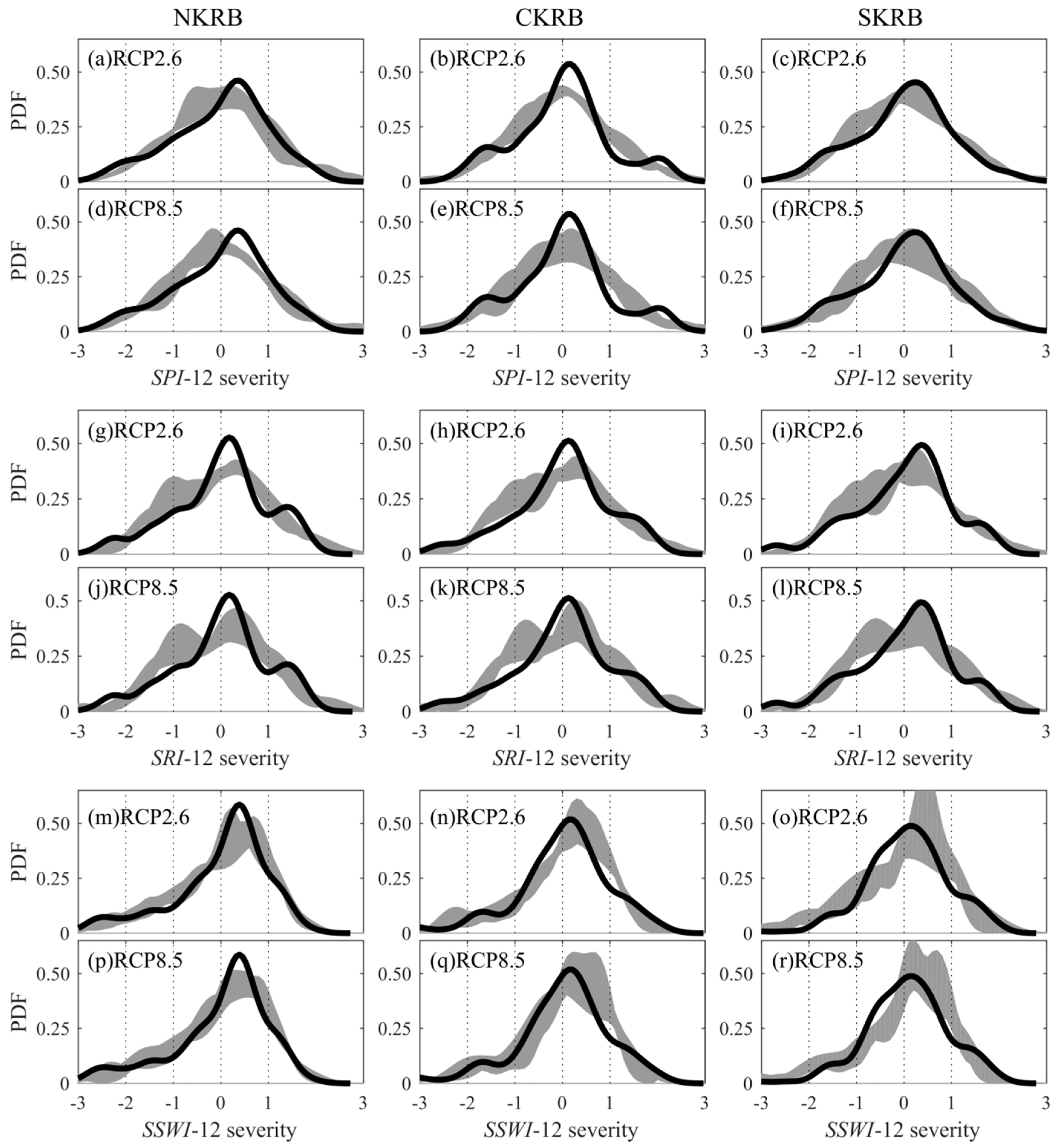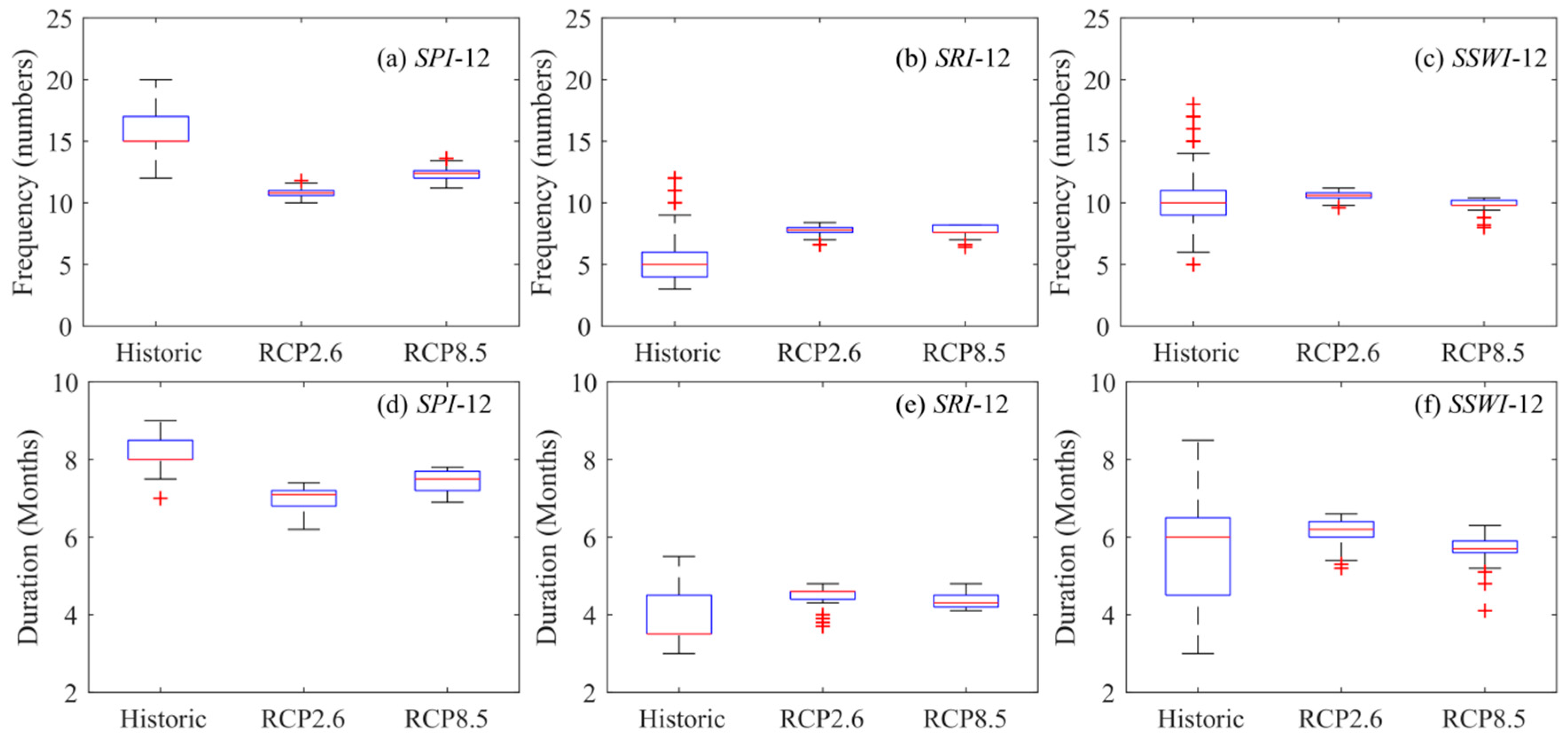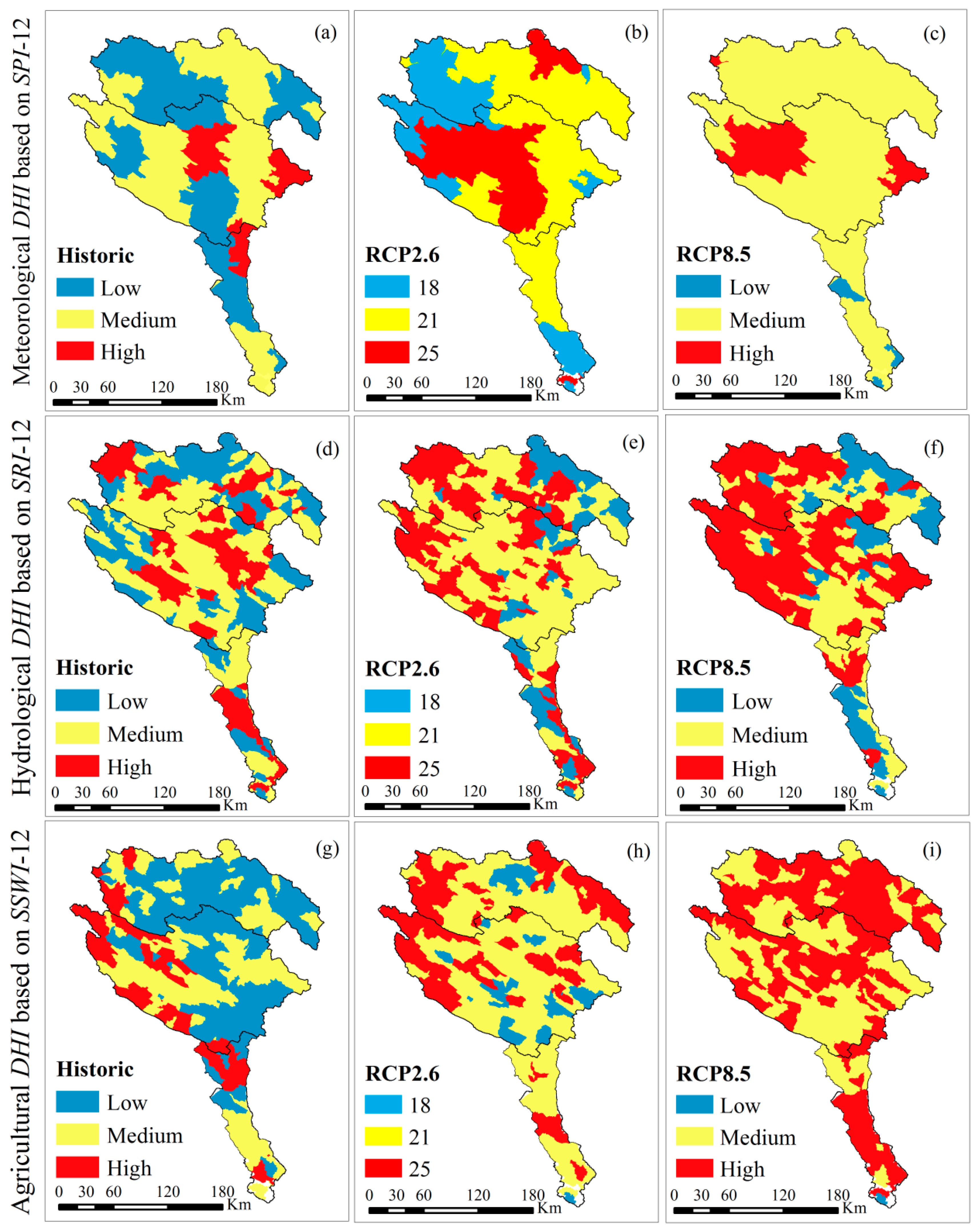Multilevel Drought Hazard Assessment under Climate Change Scenarios in Semi-Arid Regions—A Case Study of the Karkheh River Basin in Iran
Abstract
:1. Introduction
2. Materials and Methods
2.1. Study Area
2.2. Agro-Hydrological Simulation and Model Calibration
2.3. Model Set-Up and Data
2.4. Drought Analysis Methods
2.5. Drought Hazard Index
3. Results
3.1. Performance of the KRB Hydrologic Model
3.2. Temporal Propagation of Droughts in Historic Period
3.3. Future Characteristics of Droughts (Severity-Frequency-Duration)
3.4. Composite Droughts Index, DHI
4. Discussion and Conclusions
Supplementary Materials
Acknowledgments
Author Contributions
Conflicts of Interest
References
- Vidal, J.P.; Martin, E.; Franchisteguy, L.; Habets, F.; Soubeyroux, J.M.; Blanchard, M.; Baillon, M. Multilevel and multiscale drought reanalysis over France with the Safran-Isba-Modcou hydrometeorological suite. Hydrol. Earth Syst. Sci. 2010, 14, 459–478. [Google Scholar] [CrossRef]
- Dai, A.G. Drought under global warming: A review. WIREs Clim. Chang. 2011, 2, 45–65. [Google Scholar] [CrossRef]
- Vicente-Serrano, S.M.; Begueria, S.; Lorenzo-Lacruz, J.; Camarero, J.J.; Lopez-Moreno, J.I.; Azorin-Molina, C.; Revuelto, J.; Moran-Tejeda, E.; Sanchez-Lorenzo, A. Performance of drought indices for ecological, agricultural, and hydrological applications. Earth Interact. 2012, 16, 1–27. [Google Scholar] [CrossRef]
- Peters, E.; Bier, G.; van Lanen, H.A.J.; Torfs, P.J.J.F. Propagation and spatial distribution of drought in a groundwater catchment. J. Hydrol. 2006, 321, 257–275. [Google Scholar] [CrossRef]
- Wilhite, D.A.; Glantz, M.H. Understanding the drought phenomenon: The role of definitions. Water Int. 1985, 10, 111–120. [Google Scholar] [CrossRef]
- Orville, H.D. American meteorological society statement on meteorological drought. Bull. Am. Meteorol. Soc. 1990, 71, 1021–1023. [Google Scholar]
- Wang, D.B.; Hejazi, M.; Cai, X.M.; Valocchi, A.J. Climate change impact on meteorological, agricultural, and hydrological drought in central Illinois. Water Resour Res. 2011, 47. [Google Scholar] [CrossRef]
- Lglesias, L.; Garrote, L.; Cancelliere, A.; Cubillo, F.; Wilhite, D. Coping with Drought Risk in Agriculture and Water Supply Systems, Drought Management and Policy Development in the Mediterranean, 1st ed.; Springer: Dordrecht, The Netherlands, 2009; p. 320. [Google Scholar]
- Koutroulis, A.G.; Vrohidou, A.E.K.; Tsanis, I.K. Spatiotemporal characteristics of meteorological drought for the Island of Crete. J. Hydrometeorol. 2011, 12, 206–226. [Google Scholar] [CrossRef]
- McKee, T.B.; Doesken, N.J.; Kleist, J. The relationship of drought frequency and duration to time scales. In Proceedings of the 8th Conference on Applied Climatology, Anaheim, CA, USA, 17–22 January 1993; pp. 179–184. [Google Scholar]
- Stagge, J.H.; Kohn, I.; Tallaksen, L.M.; Stahl, K. Modeling drought impact occurrence based on meteorological drought indices in Europe. J. Hydrol. 2015, 530, 37–50. [Google Scholar] [CrossRef]
- Belayneh, A.; Adamowski, J.; Khalil, B.; Ozga-Zielinski, B. Long-term SPI drought forecasting in the Awash River Basin in Ethiopia using wavelet neural network and wavelet support vector regression models. J. Hydrol. 2014, 508, 418–429. [Google Scholar] [CrossRef]
- Moreira, E.E.; Pires, C.L.; Pereira, L.S. SPI drought class predictions driven by the North Atlantic Oscillation index using log-linear modeling. Water 2016, 8, 1–18. [Google Scholar] [CrossRef]
- Hisdal, H.; Tallaksen, L.M. Estimation of regional meteorological and hydrological drought characteristics: A case study for Denmark. J. Hydrol. 2003, 281, 230–247. [Google Scholar] [CrossRef]
- Liu, B.; Zhou, X.; Li, W.; Lu, C.; Shu, L. Spatiotemporal characteristics of groundwater drought and its response to meteorological drought in Jiangsu Province, China. Water 2016, 8, 1–21. [Google Scholar] [CrossRef]
- Tallaksen, L.M.; Hisdal, H.; Van Lanen, H.A.J. Space-time modelling of catchment scale drought characteristics. J. Hydrol. 2009, 375, 363–372. [Google Scholar] [CrossRef]
- Tadesse, T.; Brown, J.F.; Hayes, M.J. A new approach for predicting drought-related vegetation stress: Integrating satellite, climate, and biophysical data over the US central plains. ISPRS J. Photogramm. 2005, 59, 244–253. [Google Scholar] [CrossRef]
- Tokarczyk, T.; Szalinska, W. Combined analysis of precipitation and water deficit for drought hazard assessment. Hydrol. Sci. J. 2014, 59, 1675–1689. [Google Scholar] [CrossRef]
- Duan, K.; Mei, Y.D. Comparison of meteorological, hydrological and agricultural drought responses to climate change and uncertainty assessment. Water Resour. Manag. 2014, 28, 5039–5054. [Google Scholar] [CrossRef]
- Trenberth, K.E.; Dai, A.G.; van der Schrier, G.; Jones, P.D.; Barichivich, J.; Briffa, K.R.; Sheffield, J. Global warming and changes in drought. Nat. Clim. Chang. 2014, 4, 17–22. [Google Scholar] [CrossRef]
- Rummukainen, M. Changes in climate and weather extremes in the 21st century. WIREs Clim. Chang. 2012, 3, 115–129. [Google Scholar] [CrossRef]
- Touma, D.; Ashfaq, M.; Nayak, M.A.; Kao, S.C.; Diffenbaugh, N.S. A multi-model and multi-index evaluation of drought characteristics in the 21st century. J. Hydrol. 2015, 526, 196–207. [Google Scholar] [CrossRef]
- Wilhite, D.A.; Sivakumar, M.V.K.; Pulwarty, R. Managing drought risk in a changing climate: The role of national drought policy. Weather Clim. Extremes 2014, 3, 4–13. [Google Scholar] [CrossRef]
- Awal, R.; Bayabil, H.K.; Fares, A. Analysis of potential future climate and climate Extremes in the Brazos Headwaters basin, Texas. Water 2016, 8, 1–18. [Google Scholar] [CrossRef]
- Lu, G.; Wu, H.; Xiao, H.; He, H.; Wu, Z. Impact of climate change on drought in the upstream Yangtze river region. Water 2016, 8, 1–20. [Google Scholar] [CrossRef]
- Lee, J.H.; Kim, C.J. A multimodel assessment of the climate change effect on the drought severity-duration-frequency relationship. Hydrol. Processes 2013, 27, 2800–2813. [Google Scholar] [CrossRef]
- Leng, G.Y.; Tang, Q.H.; Rayburg, S. Climate change impacts on meteorological, agricultural and hydrological droughts in China. Glob. Planet Chang. 2015, 126, 23–34. [Google Scholar] [CrossRef]
- Liu, L.; Hong, Y.; Bednarczyk, C.N.; Yong, B.; Shafer, M.A.; Riley, R.; Hocker, J.E. Hydro-climatological drought analyses and projections using meteorological and hydrological drought indices: A case study in Blue river basin, Oklahoma. Water Resour. Manag. 2012, 26, 2761–2779. [Google Scholar] [CrossRef]
- Han, L.Y.; Zhang, Q.; Ma, P.L.; Jia, J.Y.; Wang, J.S. The spatial distribution characteristics of a comprehensive drought risk index in southwestern China and underlying causes. Theor. Appl. Climatol. 2016, 124, 517–528. [Google Scholar] [CrossRef]
- Oweis, T.; Siadat, H.; Abbasi, F. Improving On-Farm Agricultural Water Productivity in the Karkheh River Basin (KRB); CPWF Project Report-Project Number 08: CGIAR Challenge Program on Water and Food; Department for International Development: Chatham, UK, 2009. [Google Scholar]
- Vaghefi, S.A.; Abbaspour, K.C.; Faramarzi, M.; Srinivasan, R.; Arnold, J.G. Modeling crop water productivity using a coupled SWAT–MODSIM model. Water 2017, 9, 1–15. [Google Scholar]
- Sietz, D.; Feola, G. Resilience in the rural Andes: Critical dynamics, constraints and emerging opportunities. Reg. Environ. Chang. 2016, 16, 2163–2169. [Google Scholar] [CrossRef]
- Millennium Ecosystem Assessment. Ecosystems and Human Well-Being: Synthesis; Island Press: Washington, DC, USA, 2005. [Google Scholar]
- Vaghefi, S.A.; Mousavi, S.J.; Abbaspour, K.C.; Srinivasan, R.; Arnold, J.R. Integration of hydrologic and water allocation models in basin-scale water resources management considering crop pattern and climate change: Karkheh River Basin in Iran. Reg. Environ. Chang. 2015, 15, 475–484. [Google Scholar] [CrossRef]
- Masih, I.; Ahmad, M.U.D.; Uhlenbrook, S.; Turral, H.; Karimi, P. Analysing streamflow variability and water allocation for sustainable management of water resources in the semi-arid Karkheh river basin, Iran. Phys. Chem. Earth 2009, 34, 329–340. [Google Scholar] [CrossRef]
- Jamali, S.; Abrishamchi, A.; Marino, M.A.; Abbasnia, A. Climate change impact assessment on hydrology of Karkheh Basin, Iran. Proc. Inst. Civ. Eng.-Water Manag. 2013, 166, 93–104. [Google Scholar] [CrossRef]
- Zamani, R.; Tabari, H.; Willems, P. Extreme streamflow drought in the Karkheh river basin (Iran): Probabilistic and regional analyses. Nat. Hazards 2015, 76, 327–346. [Google Scholar] [CrossRef]
- Golian, S.; Mazdiyasni, O.; AghaKouchak, A. Trends in meteorological and agricultural droughts in Iran. Theor. Appl. Climatol. 2015, 119, 679–688. [Google Scholar] [CrossRef]
- Vaghefi, S.A.; Mousavi, S.J.; Abbaspour, K.C.; Srinivasan, R.; Yang, H. Analyses of the impact of climate change on water resources components, drought and wheat yield in semiarid regions: Karkheh river basin in Iran. Hydrol. Processes 2014, 28, 2018–2032. [Google Scholar] [CrossRef]
- Ahmad, M.U.D.; Giordano, M. The Karkheh river basin: The food basket of Iran under pressure. Water Int. 2010, 35, 522–544. [Google Scholar] [CrossRef]
- Marjanizadeh, S.; Qureshi, A.S.; Turral, H.; Talebzadeh, P. From Mesopotamia to the Third Millennium: The Historical Trajectory of Water Development and Use in the Karkheh River Basin, Iran; IWMI Working Paper 135; International Water Management Institute: Colombo, Sri Lanka, 2009. [Google Scholar]
- Arnold, J.G.; Srinivasan, R.; Muttiah, R.S.; Williams, J.R. Large area hydrologic modeling and assessment—Part 1: Model development. J. Am. Water Resour. Assoc. 1998, 34, 73–89. [Google Scholar] [CrossRef]
- Hjelmfelt, A.T. Investigation of Curve Number Procedure. J. Hydraul. Eng.—ASCE 1991, 117, 725–737. [Google Scholar] [CrossRef]
- Neitsch, S.L.; Arnold, J.G.; Kiniry, J.R.; Williams, J.R.; King, K.W. Soil and Water Assessment Tool; Theoretical Documentation: Version 2009; Texas Water Resources Institute: College Station, TX, USA, 2005. [Google Scholar]
- Abbaspour, K.C.; Yang, J.; Maximov, I.; Siber, R.; Bogner, K.; Mieleitner, J.; Zobrist, J.; Srinivasan, R. Modelling hydrology and water quality in the pre-ailpine/alpine Thur watershed using SWAT. J. Hydrol. 2007, 333, 413–430. [Google Scholar] [CrossRef]
- Krause, P.; Boyle, D.P.; Bäse, F. Comparison of different efficiency criteria for hydrological model assessment. Adv. Geosci. 2005, 5, 89–97. [Google Scholar] [CrossRef]
- Abbaspour, K.C.; Faramarzi, M.; Ghasemi, S.S.; Yang, H. Assessing the impact of climate change on water resources in Iran. Water Resour. Res. 2009, 45, 1–16. [Google Scholar] [CrossRef]
- Nash, J.E.; Sutcliffe, J.V. River flow forecasting through conceptual models part I—A discussion of principles. J. Hydrol. 1970, 10, 282–290. [Google Scholar] [CrossRef]
- Jarvis, A.; Reuter, H.; Nelson, A.; Guevara, E. Hole-Filled SRTM for the Globe Version 4, the CGIAR-CSI SRTM 90m Database. Available online: http://srtm.csi.cgiar.org (accessed on January 2008).
- Schuol, J.; Abbaspour, K.C.; Yang, H.; Srinivasan, R.; Zehnder, A.J.B. Modeling blue and green water availability in Africa. Water Resour. Res. 2008, 44, 1–18. [Google Scholar] [CrossRef]
- Weedon, G.P.; Gomes, S.; Viterbo, P.; Shuttleworth, W.J.; Blyth, E.; Osterle, H.; Adam, J.C.; Bellouin, N.; Boucher, O.; Best, M. Creation of the WATCH forcing data and its use to assess global and regional reference crop evaporation over land during the twentieth century. J. Hydrometeorol. 2011, 12, 823–848. [Google Scholar] [CrossRef]
- IWPCO (Iran Water and Power Resources Development Company). Systematic Planning of Karkheh Watershed; Land Use Studies (Available in Persian); Iran Water and Power Resources Development Company: Iranian Ministry of Energy, Tehran, Iran, 2009. [Google Scholar]
- IWPCO (Iran Water and Power Resources Development Company). Systematic Studies of Karkheh River Basin (Available in Persian); Iran Water and Power Resources Development Company: Iranian Ministry of Energy, Tehran, Iran, 2010. [Google Scholar]
- Hagemann, S.; Chen, C.; Haerter, J.O.; Heinke, J.; Gerten, D.; Piani, C. Impact of a statistical bias correction on the projected hydrological changes obtained from three GCMs and two hydrology models. J. Hydrometeorol. 2011, 12, 556–578. [Google Scholar] [CrossRef]
- Hempel, S.; Frieler, K.; Warszawski, L.; Schewe, J.; Piontek, F. A trend-preserving bias correction—The ISI-MIP approach. Earth Syst. Dyn. 2013, 4, 219–236. [Google Scholar] [CrossRef]
- Wilby, R.L.; Wigley, T.M.L. Downscaling general circulation model output: A review of methods and limitations. Prog. Phys. Geogr. 1997, 21, 530–548. [Google Scholar] [CrossRef]
- Rouholahnejad, E.; Abbaspour, K.C.; Vejdani, M.; Srinivasan, R.; Schulin, R.; Lehmann, A. A parallelization framework for calibration of hydrological models. Environ. Model. Softw. 2012, 31, 28–36. [Google Scholar] [CrossRef]
- Bordi, I.; Frigio, S.; Parenti, P.; Speranza, A.; Sutera, A. The analysis of the Standardized Precipitation Index in the Mediterranean area: Large-scale patterns. Ann. Geophys. 2001, 44, 965–978. [Google Scholar]
- Lloyd-Hughes, B.; Saunders, M.A. A drought climatology for Europe. Int. J. Climatol. 2002, 22, 1571–1592. [Google Scholar] [CrossRef]
- Hao, Z.; AghaKouchak, A.; Nakhjiri, N.; Farahmand, A. Global integrated drought monitoring and prediction system. Sci. Data 2014, 140001. [Google Scholar] [CrossRef] [PubMed]
- Mo, K.C. Model-based drought indices over the United States. J. Hydrometeorol. 2008, 9, 1212–1230. [Google Scholar] [CrossRef]
- Shahid, S.; Behrawan, H. Drought risk assessment in the western part of Bangladesh. Nat. Hazards 2008, 46, 391–413. [Google Scholar] [CrossRef]
- Rajsekhar, D.; Singh, V.P.; Mishra, A.K. Integrated drought causality, hazard, and vulnerability assessment for future socioeconomic scenarios: An information theory perspective. J. Geophys. Res.-Atmos. 2015, 120, 6346–6378. [Google Scholar] [CrossRef]
- Jenks, G.F. The Data Model Concept in Statistical Mapping. Int. Yearbook Cartogr. 1967, 7, 186–190. [Google Scholar]
- Gocic, M.; Trajkovic, S. Analysis of precipitation and drought data in Serbia over the period 1980–2010. J. Hydrol. 2013, 494, 32–42. [Google Scholar] [CrossRef]
- Raziei, T.; Saghafian, B.; Paulo, A.A.; Pereira, L.S.; Bordi, I. Spatial patterns and temporal variability of drought in western Iran. Water Resour. Manag. 2009, 23, 439–455. [Google Scholar] [CrossRef]
- Wilhite, D.A. Drought Assessment, Management, and Planning: Theory and Case Studies; Springer: New York, NY, USA, 1993; Volume 2. [Google Scholar]
- Stefan, S.; Ghioca, M.; Rimbu, N.; Boroneant, C. Study of meteorological and hydrological drought in southern Romania from observational data. Int. J. Climatol. 2004, 24, 871–881. [Google Scholar] [CrossRef]
- Tallaksen, L.M.; van Lanen, H.A.J. Hydrological Drought: Processes and Estimation Methods for Streamflow and Groundwater; Developments in Water Science; Elsevier: Amsterdam, The Netherlands, 2004; p. 579. [Google Scholar]
- Rubel, F.; Kottek, M. Observed and projected climate shifts 1901–2100 depicted by world maps of the Koppen-Geiger climate classification. Meteorol. Z. 2010, 19, 135–141. [Google Scholar]
- Sietz, D. Regionalisation of global insights into dryland vulnerability: Better reflecting smallholders’ vulnerability in Northeast Brazil. Glob. Environ. Chang. 2014, 25, 173–185. [Google Scholar] [CrossRef]





| GCM Name | Institute Full Name |
|---|---|
| HadGEM2-ES | Met Office Hadley Centre (additional HadGEM2-ES realizations contributed by Instituto Nacional de Pesquisas Espaciais) |
| IPSL-CM5A-LR | Institute Pierre-Simon Laplace |
| GFDL-ESM2M | NOAA Geophysical Fluid Dynamics Laboratory-Earth System Model |
| MIROC-ESM-CHEM | Japan Agency for Marine-Earth Science and Technology, Atmosphere and Ocean Research Institute (The University of Tokyo) and National Institute for Environmental Studies |
| NorESM1-M | Norwegian Climate Centre-Earth System Model |
| Class | SPI, SRI, SSWI Values | Weight | Rates Based on % of Occurrence Probability (Pr) |
|---|---|---|---|
| Extreme wet | Larger than 1 | 0 | - |
| Wet | 0 to 0.99 | 0 | - |
| Mild | −0.99 to 0 | W1 = 1 | If (17.9 < Pr ≤ 25.7) → R1 = 1 |
| If (25.7 < Pr ≤ 30.4) → R1 = 2 | |||
| If (30.4 < Pr ≤ 34.6) → R1 = 3 | |||
| Moderate | −1.49 to −1 | W2 = 2 | If (5.9 < Pr ≤ 8.3) → R2 = 1 |
| If (8.3 < Pr ≤ 10.3) → R2 = 2 | |||
| If (10.3 < Pr ≤ 13) → R2 = 3 | |||
| Severe | −1.99 to −1.5 | W3 = 3 | If (1.5 < Pr ≤ 3.7) → R3 = 1 |
| If (3.7 < Pr ≤ 5.6) → R3 = 2 | |||
| If (5.6 < Pr ≤ 8.3) → R3 = 3 | |||
| Extreme | Smaller than −2 | W4 = 4 | If (0.7 < Pr ≤ 2.2) → R4 = 1 |
| If (2.2 < Pr ≤ 3.4) → R4 = 2 | |||
| If (3.4 < Pr ≤ 7.6) → R4 = 3 |
| Outlet Names | Calibration Period (1988–2012) | Validation Period (1980–1987) | ||||||
|---|---|---|---|---|---|---|---|---|
| p-Factor | r-Factor | bR2 | NS | p-Factor | r-Factor | bR2 | NS | |
| Akan | 0.56 | 1.04 | 0.51 | 0.37 | 0.66 | 1.17 | 0.57 | 0.51 |
| Polchehr | 0.57 | 0.82 | 0.49 | 0.55 | 0.70 | 0.92 | 0.54 | 0.50 |
| Ghurbagestan | 0.74 | 0.83 | 0.59 | 0.67 | 0.73 | 0.93 | 0.71 | 0.66 |
| Haleilan | 0.67 | 0.82 | 0.62 | 0.65 | 0.73 | 0.95 | 0.68 | 0.62 |
| Tangsaz | 0.75 | 0.93 | 0.64 | 0.66 | 0.65 | 1.09 | 0.73 | 0.54 |
| Afrine | 0.53 | 0.66 | 0.46 | 0.56 | 0.63 | 0.58 | 0.37 | 0.42 |
| Jelogir | 0.64 | 0.89 | 0.67 | 0.66 | 0.71 | 1.12 | 0.67 | 0.59 |
| Payepol | 0.52 | 1.04 | 0.38 | 0.13 | 0.64 | 1.08 | 0.56 | 0.27 |
| Hamidieh | 0.55 | 1.08 | 0.43 | 0.18 | 0.65 | 1.23 | 0.51 | 0.17 |
| Catchment | SPI-1 | SPI-3 | SPI-6 | SPI-9 | SPI-12 | SPI-24 | |
|---|---|---|---|---|---|---|---|
| NKRB | SRI-1 | 0.55 | 0.27 | 0.12 | 0.05 | 0.07 | 0.09 |
| SRI-3 | 0.83 | 0.71 | 0.38 | 0.23 | 0.16 | 0.16 | |
| SRI-6 | 0.76 | 0.87 | 0.77 | 0.53 | 0.40 | 0.35 | |
| SRI-9 | 0.64 | 0.74 | 0.85 | 0.77 | 0.59 | 0.47 | |
| SRI-12 | 0.58 | 0.65 | 0.75 | 0.81 | 0.76 | 0.56 | |
| SRI-24 | 0.42 | 0.50 | 0.60 | 0.64 | 0.68 | 0.83 | |
| CKRB | SRI-1 | 0.49 | 0.24 | 0.10 | 0.05 | 0.07 | 0.10 |
| SRI-3 | 0.79 | 0.66 | 0.37 | 0.23 | 0.18 | 0.19 | |
| SRI-6 | 0.72 | 0.83 | 0.76 | 0.53 | 0.42 | 0.40 | |
| SRI-9 | 0.61 | 0.73 | 0.85 | 0.78 | 0.62 | 0.54 | |
| SRI-12 | 0.54 | 0.64 | 0.75 | 0.82 | 0.80 | 0.64 | |
| SRI-24 | 0.39 | 0.50 | 0.62 | 0.66 | 0.71 | 0.87 | |
| SKRB | SRI-1 | 0.36 | 0.20 | 0.11 | 0.07 | 0.08 | 0.12 |
| SRI-3 | 0.60 | 0.51 | 0.32 | 0.22 | 0.18 | 0.25 | |
| SRI-6 | 0.46 | 0.56 | 0.57 | 0.43 | 0.35 | 0.41 | |
| SRI-9 | 0.41 | 0.49 | 0.64 | 0.58 | 0.48 | 0.49 | |
| SRI-12 | 0.37 | 0.48 | 0.61 | 0.67 | 0.64 | 0.58 | |
| SRI-24 | 0.26 | 0.36 | 0.47 | 0.51 | 0.56 | 0.79 | |
| NKRB | SSWI-1 | 0.63 | 0.30 | 0.16 | 0.09 | 0.10 | 0.10 |
| SSWI-3 | 0.70 | 0.65 | 0.37 | 0.27 | 0.23 | 0.19 | |
| SSWI-6 | 0.67 | 0.79 | 0.74 | 0.56 | 0.49 | 0.41 | |
| SSWI-9 | 0.57 | 0.71 | 0.81 | 0.78 | 0.67 | 0.56 | |
| SSWI-12 | 0.47 | 0.59 | 0.72 | 0.78 | 0.79 | 0.64 | |
| SSWI-24 | 0.32 | 0.42 | 0.50 | 0.52 | 0.56 | 0.82 | |
| CKRB | SSWI-1 | 0.68 | 0.32 | 0.15 | 0.09 | 0.09 | 0.09 |
| SSWI-3 | 0.71 | 0.68 | 0.37 | 0.26 | 0.23 | 0.20 | |
| SSWI-6 | 0.63 | 0.78 | 0.74 | 0.55 | 0.47 | 0.42 | |
| SSWI-9 | 0.51 | 0.67 | 0.77 | 0.75 | 0.63 | 0.55 | |
| SSWI-12 | 0.41 | 0.56 | 0.67 | 0.73 | 0.74 | 0.62 | |
| SSWI-24 | 0.32 | 0.41 | 0.48 | 0.50 | 0.52 | 0.75 | |
| SKRB | SSWI-1 | 0.71 | 0.45 | 0.28 | 0.19 | 0.10 | 0.14 |
| SSWI-3 | 0.62 | 0.74 | 0.50 | 0.43 | 0.28 | 0.30 | |
| SSWI-6 | 0.56 | 0.76 | 0.81 | 0.61 | 0.48 | 0.43 | |
| SSWI-9 | 0.49 | 0.69 | 0.85 | 0.83 | 0.65 | 0.53 | |
| SSWI-12 | 0.39 | 0.59 | 0.77 | 0.85 | 0.84 | 0.63 | |
| SSWI-24 | 0.32 | 0.43 | 0.53 | 0.53 | 0.56 | 0.88 | |
© 2017 by the authors. Licensee MDPI, Basel, Switzerland. This article is an open access article distributed under the terms and conditions of the Creative Commons Attribution (CC BY) license (http://creativecommons.org/licenses/by/4.0/).
Share and Cite
Kamali, B.; Houshmand Kouchi, D.; Yang, H.; Abbaspour, K.C. Multilevel Drought Hazard Assessment under Climate Change Scenarios in Semi-Arid Regions—A Case Study of the Karkheh River Basin in Iran. Water 2017, 9, 241. https://doi.org/10.3390/w9040241
Kamali B, Houshmand Kouchi D, Yang H, Abbaspour KC. Multilevel Drought Hazard Assessment under Climate Change Scenarios in Semi-Arid Regions—A Case Study of the Karkheh River Basin in Iran. Water. 2017; 9(4):241. https://doi.org/10.3390/w9040241
Chicago/Turabian StyleKamali, Bahareh, Delaram Houshmand Kouchi, Hong Yang, and Karim C. Abbaspour. 2017. "Multilevel Drought Hazard Assessment under Climate Change Scenarios in Semi-Arid Regions—A Case Study of the Karkheh River Basin in Iran" Water 9, no. 4: 241. https://doi.org/10.3390/w9040241
APA StyleKamali, B., Houshmand Kouchi, D., Yang, H., & Abbaspour, K. C. (2017). Multilevel Drought Hazard Assessment under Climate Change Scenarios in Semi-Arid Regions—A Case Study of the Karkheh River Basin in Iran. Water, 9(4), 241. https://doi.org/10.3390/w9040241






